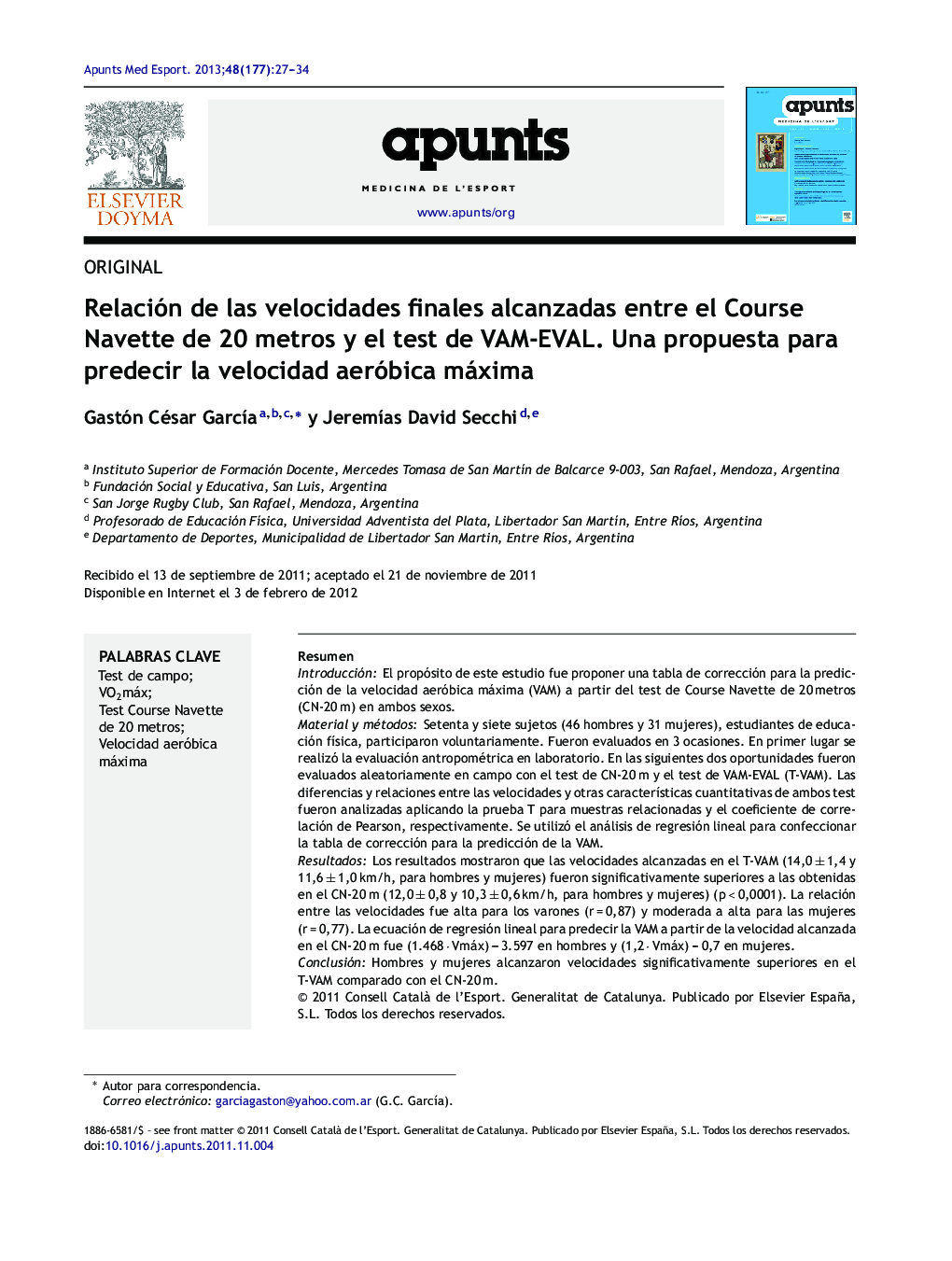| Article ID | Journal | Published Year | Pages | File Type |
|---|---|---|---|---|
| 2738831 | Apunts. Medicina de l'Esport | 2013 | 8 Pages |
ResumenIntroducciónEl propósito de este estudio fue proponer una tabla de corrección para la predicción de la velocidad aeróbica máxima (VAM) a partir del test de Course Navette de 20 metros (CN-20 m) en ambos sexos.Material y métodosSetenta y siete sujetos (46 hombres y 31 mujeres), estudiantes de educación física, participaron voluntariamente. Fueron evaluados en 3 ocasiones. En primer lugar se realizó la evaluación antropométrica en laboratorio. En las siguientes dos oportunidades fueron evaluados aleatoriamente en campo con el test de CN-20 m y el test de VAM-EVAL (T-VAM). Las diferencias y relaciones entre las velocidades y otras características cuantitativas de ambos test fueron analizadas aplicando la prueba T para muestras relacionadas y el coeficiente de correlación de Pearson, respectivamente. Se utilizó el análisis de regresión lineal para confeccionar la tabla de corrección para la predicción de la VAM.ResultadosLos resultados mostraron que las velocidades alcanzadas en el T-VAM (14,0 ± 1,4 y 11,6 ± 1,0 km/h, para hombres y mujeres) fueron significativamente superiores a las obtenidas en el CN-20 m (12,0 ± 0,8 y 10,3 ± 0,6 km/h, para hombres y mujeres) (p < 0,0001). La relación entre las velocidades fue alta para los varones (r = 0,87) y moderada a alta para las mujeres (r = 0,77). La ecuación de regresión lineal para predecir la VAM a partir de la velocidad alcanzada en el CN-20 m fue (1.468 · Vmáx) – 3.597 en hombres y (1,2 · Vmáx) – 0,7 en mujeres.ConclusiónHombres y mujeres alcanzaron velocidades significativamente superiores en el T-VAM comparado con el CN-20 m.
IntroductionThe purpose of the study was to propose a correction chart for the prediction of the maximal speed aerobic (MAS) in the Course Navette of 20 metre test (CN-20 m) in both sexes.Material and methodsA total of 77 subjects (46 men and 31 women), physical education students, participated voluntarily. They were evaluated on 3 occasions, the first of which was an anthropometric assessment in the laboratory. On the following two occasions they were randomly assessed in the field using the CN-20 m test and the MAS-EVAL (T-MAS) test. The differences and relationships between the speeds and other quantitative characteristics of both tests were analysed by applying the Student t test for related samples, and the Pearson correlation coefficient. A linear regression analysis was performed to prepare the correction chart for prediction of the MAS.ResultsThe results showed that the speeds reached in the T-MAS (14.0 ± 1.4 km/h in men and 11.6 ± 1.0 km/h in women) were significantly higher than those obtained in the CN-20 m (12.0 ± 0,8 km/h in men and 10.3 ± 0,6 km/h in women) (P ℜ .0001). There was a high correlation between the speeds for the males (r = 0,87) and moderate to high for the women (r = 0,77). The linear regression equation to predict the MAS starting from the speed reached in the CN-20 m was (1.468 · Vmax) – 3.597 in men, and (1.2 · Vmax) – 0,7 in women.ConclusionsMen and women reached significantly higher speeds in the T-MAS in comparison with the CN-20 m test.
